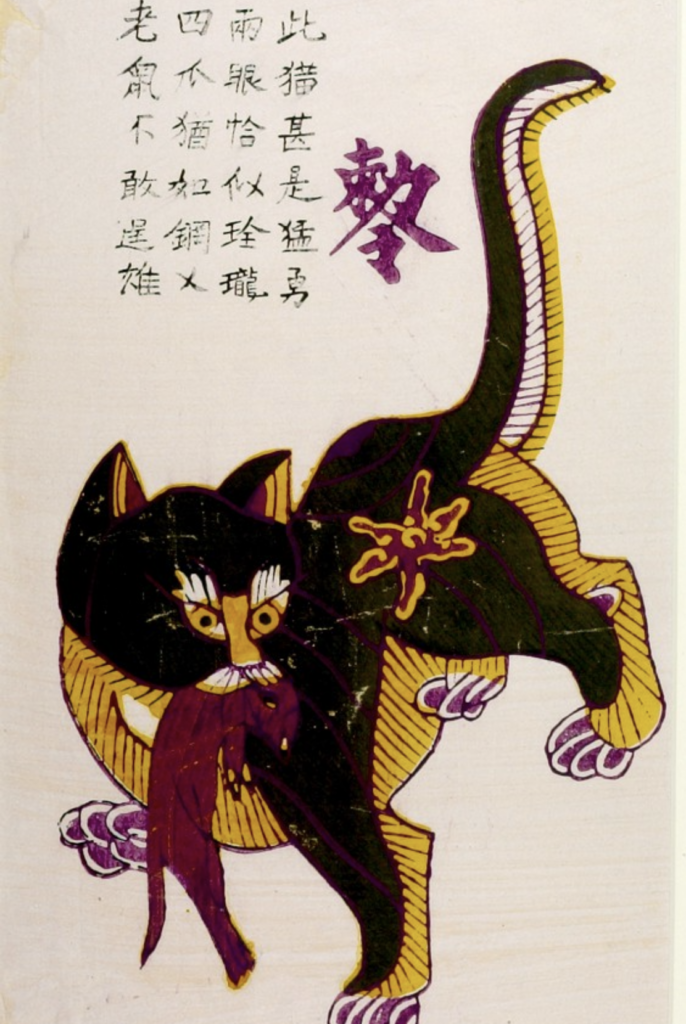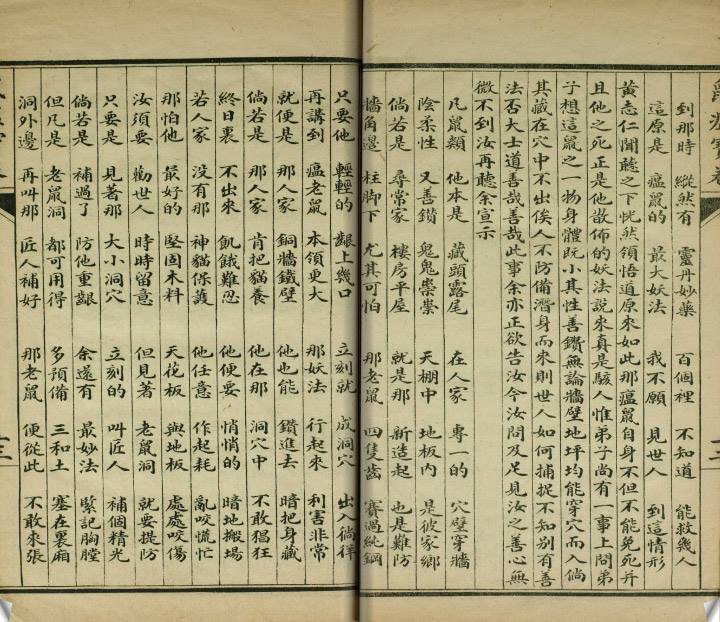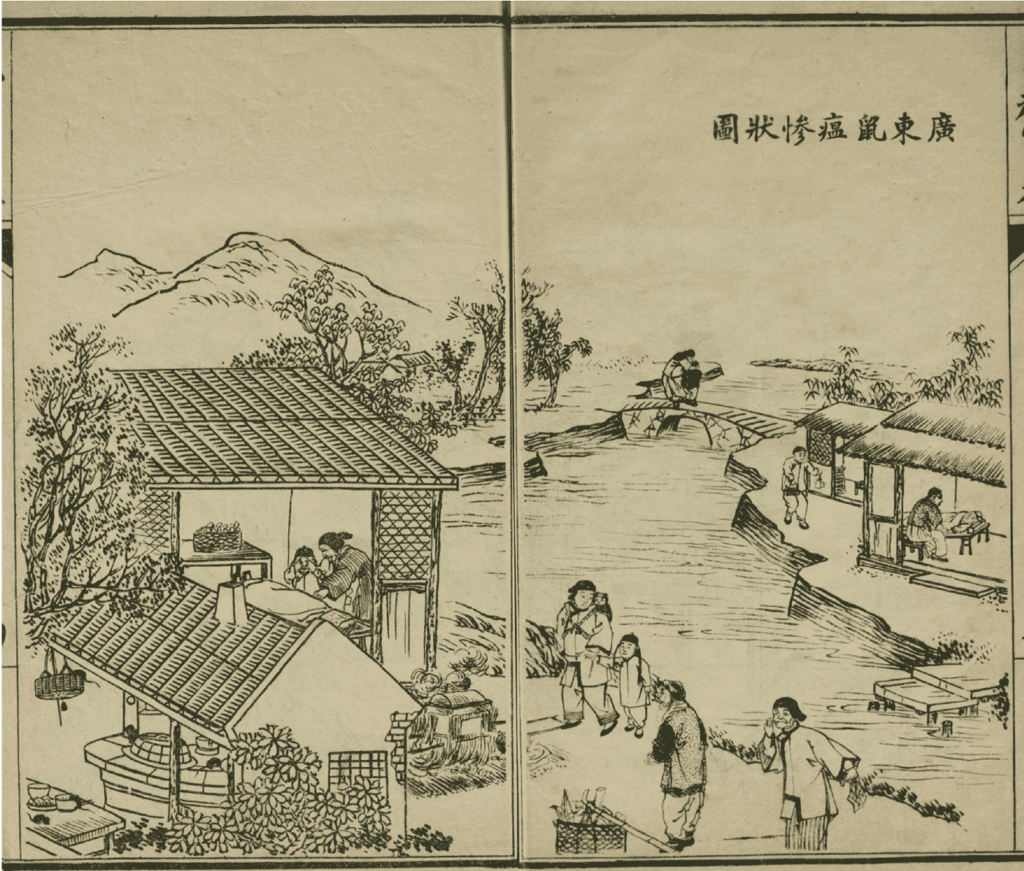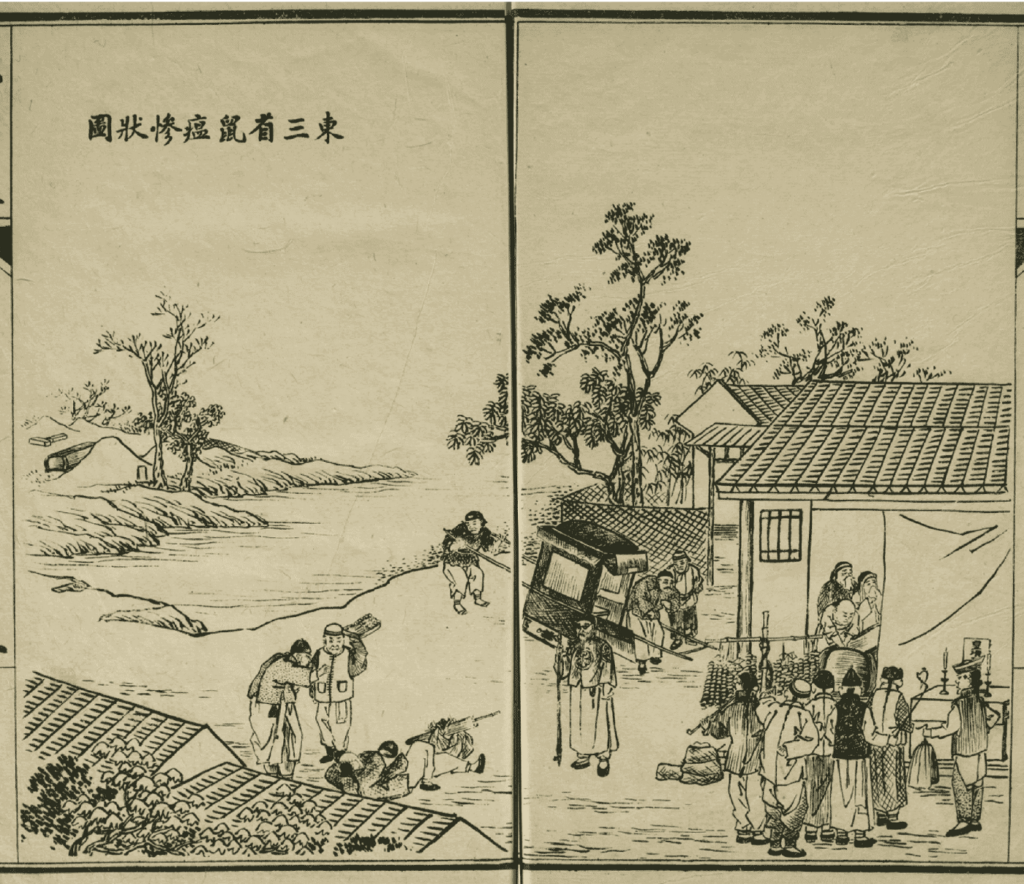Wilt Idema, Professor of Chinese Literature Emeritus at Harvard University, introduces his translation of the Precious Scroll of the Rat Epidemic (鼠溫寶卷 Shuwen baojuan), published in Shanghai in 1911. This text reflects the anxiety caused by the recurrent outbreaks of the plague during the final years of the Qing dynasty. At the same time, it presents a detailed account of the attempt of pious Buddhist layman to integrate the traditional interpretation of epidemics as divine punishments for the sins of humans, and a more modern understanding of the plague as a disease spread by rats and their fleas.
This modern understanding of disease as spread by rats and fleas may be traced to the influence of an exhibition of public health posters in Tianjin. In these posters, the bodhisattva Guanyin comes to the rescue of humankind by teaching the dangers of touching rats and giving the design of “divine tongs” for handling them, whether dead or alive; she also expounds at length on the advantages of keeping a cat.
This publication first appeared in Sino-Platonic Papers, №313 April 2021. The introduction to the translation is reproduced below with endnotes. As Professor Idema explains, “Writings on epidemics are rare, and this text is interesting in combining a traditional description of the epidemics as divine punishment for the sins of humankind with more modern ideas on the cause and spread of the plague, which may have been picked up at an exhibition of public health posters.”

During the final decades of the Qing dynasty, its subjects increasingly suffered from the plague. These outbreaks, which would continue into the twentieth century, are part of what often is called the third pandemic of the plague. While the place of origin of this third pandemic is still a matter of controversy, it is clear that several parts of Yunnan had already been visited by the bubonic plague in the second part of the eighteenth century. Over the course of the nineteenth century, this epidemic slowly made its way eastward, reaching the Pearl River Delta by 1894. From Guangzhou and Hong Kong the illness would work its way slowly up the Chinese coast, and also spread to other parts of the world. In the winter of 1910 and the spring of 1911 the three northeastern provinces in Manchuria were visited by a sudden and violent outburst of pulmonary plague. These epidemics have been studied in great detail, focusing on the clash between traditional Chinese medicine in fighting the disease and the developing Western approaches, and on the geopolitical situation of the times.
One of the most wide-spread traditional approaches to epidemics east and west saw them as divine punishment for the sins of humankind. In the Chinese case, the celestial administration of the Jade Emperor included a Department of Epidemics, which would send its representatives down to the world below to spread a disease whenever the number of sins had accumulated to such a degree that it incited the wrath of the Jade Emperor.2 The communities that were struck by the disease were well advised to implore the mercy of the Jade Emperor and his representatives by communal and individual acts of contrition and spectacular acts of veneration. These appeals to Heaven would gain strength if powerful deities such as Guan Yu 關羽 and Guanyin 觀音 (also Guanshiyin 觀世音) would intercede on behalf of mankind.3 When they did so, these deities would not be shy about publicizing their actions.

In 1894 in Guanzhou it was Guan Yu who descended into the planchette to dictate documents in which he informed his faithful that his intervention with the Jade Emperor had resulted in a promise from that authority that the number of the victims would be halved if people would only abandon their sinful ways and practice a good godly life. 4 In 1909 near Tianjin it was the bodhisattva Guanyin who summoned one of her believers, a Mr. Huang Zhiren 黃志仁, in his dream, to her celestial Potalaka Palace to inform him of a plague that would hit China from the northeast, tell him of her intercession with the Jade Emperor, and teach him how people could fight the disease not only by moral regeneration, but also by a number of practical measures. While Guan Yu’s message still very much reflected traditional Chinese conceptions about the origin of epidemics and how to fight them, Guanyin’s revelation as narrated by Li Shanbao 李善保 in the Precious Scroll of the Rat Epidemic (Shuwen baojuan 鼠溫寶卷) reflects in several ways the new ideas about the origin and spread of the plague as they had developed by that time. 5 It presents an intriguing attempt to integrate this knowledge into a more traditional understanding of epidemics: while Guanyin focuses on rats (and their fleas) as the carriers of the disease, she still identifies these rats as instruments of the Department of Epidemics, and while she stresses keeping cats as an effective precaution against the plague, she identifies these cats as denizens of heaven that are sent down to earth. As a rare document on the understanding of the plague from a period of rapid change, the Precious Scroll of the Rat Epidemic well deserves to be more widely known.

Traditional Chinese doctors were unacquainted with the symptoms and the origin of the plague as it affected China in the late Qing6 and explained its spread by reference to a contagious miasma (qi 氣). From the moment the plague manifested itself in Yunnan, local observers were aware of the fact that the sudden death of great numbers of humans was preceded by abnormal behavior and mass mortality of rats. This is clear from the “Ballad of Dying Rats” (Shusi xing 鼠死行) by a certain Shi Daonan 師道 南 (1772–1800), who himself would succumb to the plague shortly after writing this poem:
In the twentieth century this poem has often been hailed as evidence of an early Chinese awareness of the relation between rats and the plague, but while the poet describes the sudden massive demise of rats as a precursor of the sudden massive demise of humans, he does not identify the first as the cause of the second. The cause of death in Shi Daonan’s poem is the breath/miasma exhaled by the plague ghosts. It is his contemporary Hong Liangji 洪亮吉 (1746–1809) who suggests that the rats carry the “miasma.” When discussing this poem, he notes, “At that time in Zhaozhou there were weird rats that in broad daylight would enter people’s home, stretch out on the floor, vomit blood and die. If people were infected by their miasma, they also would immediately pass away.”8 But as this remark is included in a collection of critical notes on poetry, one can only wonder to what extent and how quickly it had an impact on the Chinese medical profession and on society at large during the nineteenth century.9 The first specialized Chinese treatise on the plague to treat it as an epidemic was Wu Zongyuan’s 吳宗宣Methods for Curing the Plague (Chi shuyi fa 治鼠疫法) of 1891, which was printed by Luo Rulan 羅汝蘭 in his Comprehensive Studies on the Rat Plague (Shuyi huibian 鼠疫彙編) in Guangzhou in 1895.10 This explained the disease as caused by an “earth miasma” (diqi 地氣) that, rising from below, first affects rats and then humans.11

In Guan Yu’s 1894 letter to the inhabitants of plague-stricken Guangzhou, the plague too is caused by a miasma emanating from the earth (and a nearby coal mine) and due to the sins of humankind. So the most effective way to fight the disease is through a moral regeneration. The god also revealed a most potent talisman against the plague demons: if a moral person makes a drawing of his famous halberd and writes the god’s full title on a piece of paper and pastes it on his front door, he will escape the disease. On a perhaps more practical note, the letter also includes a prescription for an antiplague medicine.12 It mentions rats only when it instructs its readers to purify private wells “because the water is becoming cooler and poisonous in the plague season, to which has been added the filthy fluid of the bodies of dead rats which has percolated into them from the drains” by garlic and other means.13 But dead animals have been a favorite means to poison drinking water since ancient times. In Guan Yu’s message to mortals it is still the plague ghosts who spread the disease.
“Rats die to the left,
Rats die to the right!
When people see dying rats it is as if they see tigers:
A few days after the rats have died,
People die like a a collapsing wall.
— Don’t ask the number
Of those who die during the day!
The sunlight is gloomy and bleak, covered by sorrowing clouds.
Before three people have walked some ten paces or more,
Two have suddenly died and, stretched out, block the road.
— When people die at night,
One doesn’t dare weep:
When plague ghosts exhale, the lamp’s green flame flickers.
In a moment a storm arises and the lamp is suddenly gone:
Man and ghost, corpse and coffin share one room in darkness.
Raven caw without end,
Dogs are heard howling.
People look like ghosts:
Ghost steal their souls.
Most of the people you meet during the bright day are ghosts
And the ghosts you encounter after dark you take for people.
Dead people cover the ground, few houses are inhabited;
Exposed to the winds, the bones slowly, slowly decay.
There is no one to harvest the grain on the fields;
From whom can the state requisition the taxes?
Astride a heavenly dragon I want to ascend to heaven,
To call on the lord of heaven and beg heaven’s mother
To sprinkle heaven’s brew and dispense heaven’s milk
And let it soak the soil of this world a thousand rods deep,
So all people below the earth will come back to life again
And the Yellow Sources will turn into a rain of spring.7″
Western medical professionals for long shared the ignorance of their Chinese colleagues about the cause of the plague and mostly relied on improved public hygiene and quarantine to contain its outbreaks. That changed in the late nineteenth century thanks to the international advances in bacteriology. During the Hong Kong plague epidemic of 1894 the French physician Alexandre Yersin (1863–1943), dispatched to Hong Kong from Hanoi, succeeded in identifying the rat-born bacteria that caused the disease, and a few years later he the role of certain kinds of fleas in the transmission of the disease from rodents to humans was also discovered. It took of course a while before the findings of these new-fangled methodologies were accepted by the Western-trained medical profession at large, let alone by the general public east and west.14 But while bacteria might be too small to become an object of annihilation, fleas and rats were large (and otherwise obnoxious) enough do so. While the author of the Precious Scroll of the Rat Epidemic does not mention bacteria and still freely uses the term “miasma,” he clearly identifies rats and their fleas as the carriers of the disease that transmit it to humans. While the ultimate cause of the plague is still sought in the sins of humans, the text strongly focuses on practical ways to deal with rats, dead or alive. The text starts out with a description of “divine tongs” (shenqian 神鉗) with very long pincers, that allow one to catch or gather rats without touching them (a picture is provided in the text on p. 6b). One is urged to destroy the dead rats by burning them. As the greatest enemy of rats is the cat, the text goes into great length in singing the virtues of keeping a cat. When the Bodhisattva Guanyin has finished her exposition on these topics, her interlocutor Mr. Huang Zhiren is taken to see a gallery of paintings (each consisting of a number of individual scenes) on the vices of rats, the virtues of the cat, and the horrors of the plague outbreaks. When Mr. Huang cannot stand looking at any more of these terrifying paintings, he returns to Guanyin who tells him that conventional religious rites are of no use in warding off epidemics and urges him to spread her message. As have other prophets when ordered to convert their fellow human beings, Mr. Huang points out that many people will be reluctant to believe him and follow his words.
The detailed description of the gallery of paintings makes one wonder whether Mr. Huang, who is described by the author Li Shanbao as his neighbor, and who does not seem to be a fictional character, may have visited an exhibition of public health posters on the cause, the manifestations, and the prevention of the plague. Tianjin was an atypical city in the final years of the Qing in having an active city sanitation department (Weishengju 卫生局), as of 1902.15 The sanitation department was actively engaged in an anti-plague campaign by spring of 1910 and most likely earlier. The picture magazine supplement of the Shenzhou ribao 神州日報on March 25, 1910, featured a lithograph titled “Catching Rats to Prevent the Plague” (Fangyi bushu 防疫捕鼠), showing workers of the sanitation department handing out mouse traps for free to every family in the city. The accompanying text informs us that the plague is the most persistent epidemic, that rats carry the disease (which is transmitted to humans by their fleas), and that captured rats, whether dead or alive, have to be handed to the sanitation department for dissection.16 This program would seem to be modeled on the measures then in force in Hong Kong. One can imagine that the handing out of free mouse traps must have been accompanied by other activities of the sanitation department to enlighten the public. If our hypothetical exhibition of public health posters took place in the spring of 1910, it cannot have been inspired by the news of the Great Manchurian Plague of 1910/1911, but Huang Zhiren’s dream most certainly was. The Precious Scroll of the Rat Epidemic dates Mr. Huang’s dream to the “the first day of the Tenth Month of the second year of Xuantong” (November 2, 1910).17 The text shows no awareness of the difference in transmission and manifestations between the bubonic plague and the pulmonary plague, but the author of the Precious Scroll of the Rat Epidemic in his postface dated to the beginning of the Eleventh Month of the same year (early December 1910) claimed to have visited Manchuria on purpose to ascertain that the actual situation corresponded to the picture of horror described by Mr. Huang.
The description of the paintings seen by Mr. Huang is intriguing. Each painting has a general heading “in the Sanskrit script, as found in Buddhist sutras,” with a few lines in Chinese characters accompanying each individual picture. Could it be that the real-life posters he had seen had originally been produced in British India (which had its own plague epidemics during the nineteenth century) and had been edited in Hong Kong for local use and elsewhere on the China coast? Unfortunately, I have to confess that so far I have failed to locate any copies of such posters if they ever existed. But if Mr. Huang saw such posters, it is tempting to explain his dream as a result of his conscious and subconscious attempts to integrate the new information he had received with his traditional understanding of epidemics. In achieving this new synthesis, he clearly drew on the well-known legend of the Five Rats Creating Havoc in the Eastern Capital. This tale circulated as early as the sixteenth century in various versions. In this tale, which is set in the eleventh century during the reign of Emperor Renzong 仁宗, five demonic rats create havoc in society and at court by their uncanny ability of taking on not only human shape, but the exact likeness of specific individuals, even of the emperor and the empress-dowager. Judge Bao 包公first has to establish their original nature as rats, and then visits heaven to borrow the Buddha’s pet cat. When he has eventually been able to do so and takes that cat to the world below, it exterminates the rats (with one exception, which explains the continuing enmity between cats and rats).18

The Precious Scroll of the Rat Epidemic is concluded by a postface in which the author of the text, Li Shanbao, explains his relationship to Mr. Huang Zhiren and his decision to use a popularizing format. From the postface to the Shanghai reprint of 1911, it would appear that Mr. Huang financed the publication of the text (no copy of that edition seems to have been preserved). He Jiong, the editor of the Shanghai reprint, complains about the rudeness of that edition. His own edition is a fine lithographic printing, which is preceded by a picture of Guanyin and her acolytes, a picture of Mr. Huang’s dream meeting with the Bodhisattva, and pictures of the horrors of the plague in Guangzhou and in Manchuria. No later editions of the text are known.
The Precious Scroll of the Rat Epidemic is written in an alternation of prose and verse. For the sections in verse, the author employs the ten-syllable line, which is subdivided into three segments of respectively three, three, and four syllables. I have tried to reproduce these metrical divisions by typographical means. The text claims to be a precious scroll. Texts in this genre were (and are) performed in an elaborate ritual setting, and many editions of precious scrolls include the texts to be recited at the opening and conclusion of the recital. The lithographic editions of precious scrolls produced in Shanghai in the late Qing still include at least an opening poem in which buddhas and bodhisattvas are invited to descend to earth and attend the event, and a poem in which these divinities are sent off again. While the Precious Scroll of the Rat Epidemic indeed begins with such a typical opening poem, it ends abruptly when Mr. Huang wakes up from his dream, and it does not include the expected closing poem that would send the invited buddhas and bodhisattvas off again. This suggests that the text was not necessarily written with a performance in mind, but was primarily composed for common readers.19
Endnotes
1 For a general survey of the plague in the latter part of the Qing dynasty, see Fisher 1995–1996. For the spread of the plague from Yunnan to Hong Kong and the Hong Kong plague, see Benedict 1996 and Pryor 1975. For literature on the Great Manchurian Plague see for instance Budberg 1923; Gamsa 2006; Knab 2011; Summers 2012; and Wu 1959. Records of epidemics in Chinese historical sources often are too general and laconic to allow us to draw conclusions about the nature of the disease concerned (Brook 2020). “There is very little representation of epidemic disease in traditional fiction, even in popular works” (Schonebaum 2016, 30).
2 Katz 1995, Ch. 2.
3 On Guan Yu, see Haar 2017. On Guanyin, see Yü 2001.
4 Anonymous 1895. This translation of Guan Yu’s messages by J. Dyer Ball was appended to the official report on the Hong Kong plague of 1894 and has often been quoted in recent scholarship. In this translation the Jade Emperor is called the “Gemmeous Ruler.” The planchette was and is widely used in Chinese spirit-writing cults. The simplest form of the planchette is a three-pronged stick. It is held by two men, and when the spirit descends in the instruments the third end leaves traces in a specially prepared plate of ash or fine sand, which are read by a specialized participant in the ritual as Chinese characters embodying the message of the divinity (Jordan and Overmyer 1986, 36–56; Kleeman 1994, 8–13).
5 Li Shanbao 1911. Che Xilun 2000, 246 lists three institutes that hold a copy of this text and claims these editions were all from Tianjin, but that cannot be true as he also mentions the second postface by He Jiong 何烱 who financed a new edition of the text in Shanghai in the spring of 1911. The text is briefly summarized by Sawada Mizuho 1975, 230–231 on the basis of the copy kept at Kyoto University. To the best of my knowledge, the text has not be reprinted in any of the recent collections of precious scrolls. The copy kept at the Museum of World Religions at Taipei was available for a while on the website of the museum, but that website has been closed. The only work of modern Chinese scholarship to pay attention to the Precious Scroll of the Rat Epidemic is Fan Xingzhun 1986, 243.
6 Benedict 1996, 105.
7 Zhou Jinguo 2013.
8 Hong Liangji 2001, vol. 5, 2285.
9 As late as 1909 a traditional Chinese physician belonging to the “Cold Damage School” published a tract titled Rat Plague Is Not an Epidemic (Shuyi fei yi 鼠疫非疫), stressing that each patient had different symptoms and needed individualized treatment (Benedict 1996, 105–106).
10 Benedict 1996, 106–107.
11 Benedict 1996, 107–109. Many of the sanitary measures proposed by Wu and Luo to prevent an outbreak of the plague are very similar to Western approaches to the disease for most of the nineteenth century.
12 Guan Yu was not the only deity to reveal prescriptions against the disease. Another planchette group received prescriptions from the ancient immortal Guangchengzi 廣成子. It continued its activities as a charity, and as such is still active in Hong Kong (Liang Qizi 2011).
13 Anonymous 1895. According to the Dianshizhai huabao 點石齋畫報, reporting on the epidemic from Shanghai, a certain Luo Fang 羅方offered to buy any dead rats because he believed the plague was caused by the foul miasma of the rotting corpses that were indiscriminately cast into ditches and toilets (Benedict 1996, 135–136).
14 Sutphen 1997. See also Andrews 1997 for the slow assimilation of germ theory in China in the case of tuberculosis.
15 Benedict 1996, 153–155; Rogaski 1999. Also see Bu 2017.
16 Xiao Yifei 2020. The rats will have been dissected to check for symptoms of the plague and inspected for the presence of plague germs.
17 The Tianjin sanitation department went into overdrive when the Great Manchurian Plague threatened the city.
18 Idema 2019, 65–81. The author of the Precious Scroll of the Rat Epidemic seems not to be aware that cats too can suffer the plague.
19 For more information on precious scrolls in the late Qing, see Berezkin 2014; Berezkin 2017.


